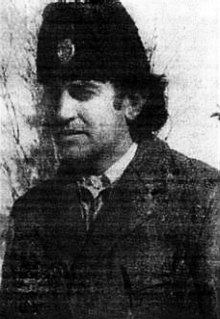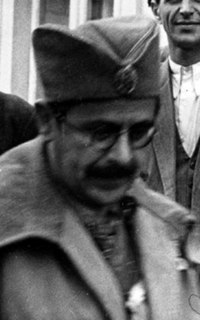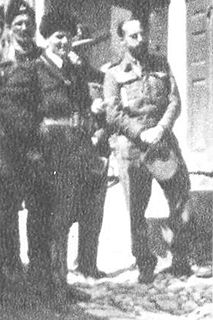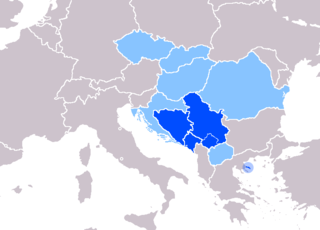
The Italian governorate of Montenegro existed from October 1941 to September 1943 as an occupied territory under military government of Fascist Italy during World War II. Although the Italians had intended to establish a quasi-independent Montenegrin kingdom, these plans were permanently shelved after a popular uprising in July 1941. Following the Italian surrender in September 1943, the territory of Montenegro was occupied by German forces which withdrew in December 1944.
Blažo Đukanović was a Montenegrin Serb Chetnik brigadier general and political leader in World War II Montenegro.

Dobroslav Jevđević was a Bosnian Serb politician and self-appointed Chetnik commander in the Herzegovina region of the Axis-occupied Kingdom of Yugoslavia during World War II. He was a member of the interwar Chetnik Association and the Organisation of Yugoslav Nationalists, a Yugoslav National Party member of the National Assembly, and a leader of the opposition to King Alexander between 1929 and 1934. The following year, he became the propaganda chief for the Yugoslav government.

Operation Alfa was an offensive carried out in early October 1942 by Italian, Croatian and Chetnik forces against the communist-led Partisans in the Prozor region, then a part of the Croatian puppet state, the Independent State of Croatia (NDH). The operation was militarily inconclusive, and in the aftermath, Chetnik forces conducted mass killings of civilians in the area.

Pavle Đurišić was a Montenegrin Serb regular officer of the Royal Yugoslav Army who became a Chetnik commander (vojvoda) and led a significant proportion of the Chetniks in Montenegro during World War II. He distinguished himself and became one of the main commanders during the popular uprising against the Italians in Montenegro in July 1941, but later collaborated with the Italians in actions against the Communist-led Yugoslav Partisans. In 1943, his troops carried out several massacres against the Muslim population of Bosnia, Herzegovina and the Sandžak, and participated in the anti-Partisan Case White offensive alongside Italian forces. Đurišić was captured by the Germans in May 1943, escaped and was recaptured.

Petar Baćović was a Bosnian Serb reserve army officer, lawyer, and then a Chetnik commander within occupied Yugoslavia during World War II. From the summer of 1941 until April 1942, he headed the cabinet of the Ministry of Internal Affairs for Milan Nedić's puppet Government of National Salvation in Belgrade. In July 1942, Baćović was appointed by the Chetnik leader Draža Mihailović and his Supreme Command as the commander of the "Chetnik Operational Units in eastern Bosnia and Herzegovina" during which he collaborated with the Italians and Germans in actions against the Yugoslav Partisans.

Zaharije Ostojić was a Montenegrin Serb military officer who served as the chief of the operational, organisational and intelligence branches of the Chetnik Supreme Command led by Draža Mihailović in Yugoslavia during World War II. He was a major in the Royal Yugoslav Army Air Force prior to the Axis invasion of Yugoslavia, and was involved in the coup that deposed Prince Paul of Yugoslavia on 27 March 1941. After the coup, he escorted Prince Paul to exile in Greece, and was in Cairo at the time of the invasion in April. In September 1941, he was landed on the Italian-occupied Montenegrin coast along with a British Special Operations Executive (SOE) liaison officer and two companions. He escorted the SOE officer to the German-occupied territory of Serbia and introduced him to the Yugoslav Partisan leader Josip Broz Tito then Mihailović. Ostojić soon became Mihailović's chief of staff, and after the German attempt to capture the Chetnik leader during Operation Mihailović in December 1941, brought the Chetnik Supreme staff to Montenegro where they were re-united with Mihailović in June 1942. During the remainder of 1942, Ostojić launched a counter-attack against Ustaše troops of the Independent State of Croatia returning to the eastern Bosnian town of Foča where they were expected to continue their genocidal anti-Serb policies. As many as 2,000 local Muslims were subsequently killed in the town by forces under Ostojić's command. Ostojić later oversaw large-scale massacres of civilians and burning of Muslim villages in the border region between Montenegro and the Sandžak.

Ismet Popovac was a Bosnian Muslim lawyer and physician who led a Muslim Chetnik militia known as the Muslim People's Military Organization (MNVO) in Bosnia and Herzegovina during World War II. He was active in pre-war Yugoslav politics, becoming a member of the Serbian Muslim cultural organization Gajret and serving as the mayor of Konjic, a town in northern Herzegovina. He is also said to have been candidate for Vladko Maček's electoral list, but was left without a job in the Yugoslav state government after the creation of the Banovina of Croatia in August 1939.

The Uprising in Montenegro(Montenegrin: Ustanak u Crnoj Gori), commonly known as the 13 July Uprising(Montenegrin: Trinaestojulski ustanak) was an uprising against Italian occupation forces in Montenegro. Initiated by the Communist Party of Yugoslavia on 13 July 1941, it was suppressed within six weeks, but continued at a much lower intensity until December 1941. The insurgents were led by a combination of communists and former Royal Yugoslav Army officers from Montenegro. Some of the officers had recently been released from prisoner-of-war camps following their capture during the invasion of Yugoslavia. The communists managed the organisation and provided political commissars, while the insurgent military forces were led by former officers. The entire nation rejected the privileged position offered by its occupiers, rejected the capitulation in order to fight for Yugoslavia, together with "Russia".
Leftist errors was a term used by the Communist Party of Yugoslavia (CPY) to describe radical policies and strategies – described as the Red Terror by others – pursued by self-described left-wing elements among the party and partisan units during World War II, mostly in Montenegro, Herzegovina and Serbia, as well as to a lesser extent in Croatia and Slovenia.

Đorđije Lašić was a Montenegrin Serb military officer of the Royal Yugoslav Army. During the Second World War he participated in the 1941 Uprising in Montenegro, but has soon turned to collaboration with Axis occupation forces until 1944, when he was killed during the bombing of Podgorica.
The Sandžak Muslim militia was established in Sandžak and eastern Herzegovina in Axis occupied Yugoslavia between April or June and August 1941 during World War II. It was under control of the Independent State of Croatia until September 1941, when Italian forces gradually put it under their command and established additional units not only in Sandžak, but in eastern Herzegovina as well. After the capitulation of Italy in September 1943 it was put under German control, while some of its units were merged with three battalions of Albanian collaborationist troops to establish the "SS Polizei-Selbstschutz-Regiment Sandschak" under command of the senior Waffen SS officer Karl von Krempler.
Mulla Rastoder was a commander of the militia in upper Bihor during the Second World War. He was a collaborator with the Italians during their World War II occupation of Bihor.
The Lim-Sandžak Chetnik Detachment was a military unit of Chetniks that was established in northern Montenegro and Sandžak at the end of June 1942, during World War II. In August 1942, it was commanded by Pavle Đurišić, and was the largest and the most elite military unit of Draža Mihailović at that time.
The 1942 Montenegro offensive was an Italian-led counter-insurgency operation of World War II, which targeted the Yugoslav Partisans in the Italian governorate of Montenegro and the eastern Herzegovina region of the Independent State of Croatia (NDH). It was carried out from mid-May to June 1942, with Chetnik forces taking part on the Italian side. The offensive followed the conclusion of the joint German-Italian Operation Trio in eastern Bosnia. Together these two operations comprise what was known as the Third Enemy Offensive in Yugoslav historiography.
Rudolf Perhinek was Yugoslav military officer with the rank of Captain in the Royal Yugoslav Army who, soon after the Axis invasion of Yugoslavia, joined Chetniks of Dragoslav Mihailović. He was a member of the Supreme Command of Mihailović's Chetniks and received the rank of Major. Perhinek, also referred as Mihailović's right hand, organized Chetniks in Montenegro at the end of 1941. In period October 1941 — September 1943 he was a special envoy of Mihailovic's Chetnik staff for Montenegro who was also responsible for the intelligence service in Montenegro and Albania. Some sources describe him as an agent of Gestapo. For some time he was the Chief of Staff of Chetnik forces under command of Vojislav Lukačević. Perhinek was an ethnic Slovene. Yugoslav Government in Exile awarded him with Order of the Star of Karađorđe.
The Bukovica massacre was a massacre of Muslims in Bukovica, Pljevlja, in the Axis-occupied Italian governorate of Montenegro. It took place February 4–7, 1943, during Pavle Đurišić's Chetniks' 1943 cleansing campaign. The massacre was aimed at establishing Chetnik control over territories held by the Sandžak Muslim militia. After a short battle with the Muslim militia, Chetniks captured Bukovica and killed over five hundred civilians.
Ćazim Sijarić was a commander of a detachment of Bosniak militia from Bijelo Polje during the Second World War. The militia in Bijelo Polje was founded by Ćazim Sijarić, Vehbo Bučan and Galjan Lukač. A deputy of Sijarić was Smajo Trubljanin.

Terence Atherton (1902–1942) was a British intelligence officer of Irish descent. As a member of the SOE he was a member of the Operation Hydra mission in the Axis occupied Yugoslavia. His task was to establish and maintain communication with the Chetnik headquarter. With other members of this mission he disembarked onto Montenegrin coast and begin his journey toward Chetnik headquarter in February 1942. He was soon noticed by Partisans who took him to their headquarter. The communists prevented Atherton to continue his trip to Chetniks and spent several weeks in futile attempts to persuade him to change his anti-communist and pro-Chetnik position. They even took him to Partisan headquarter in Foča to meet Josip Broz who was very suspicious about Atherton and warned Croatian communists about him.











